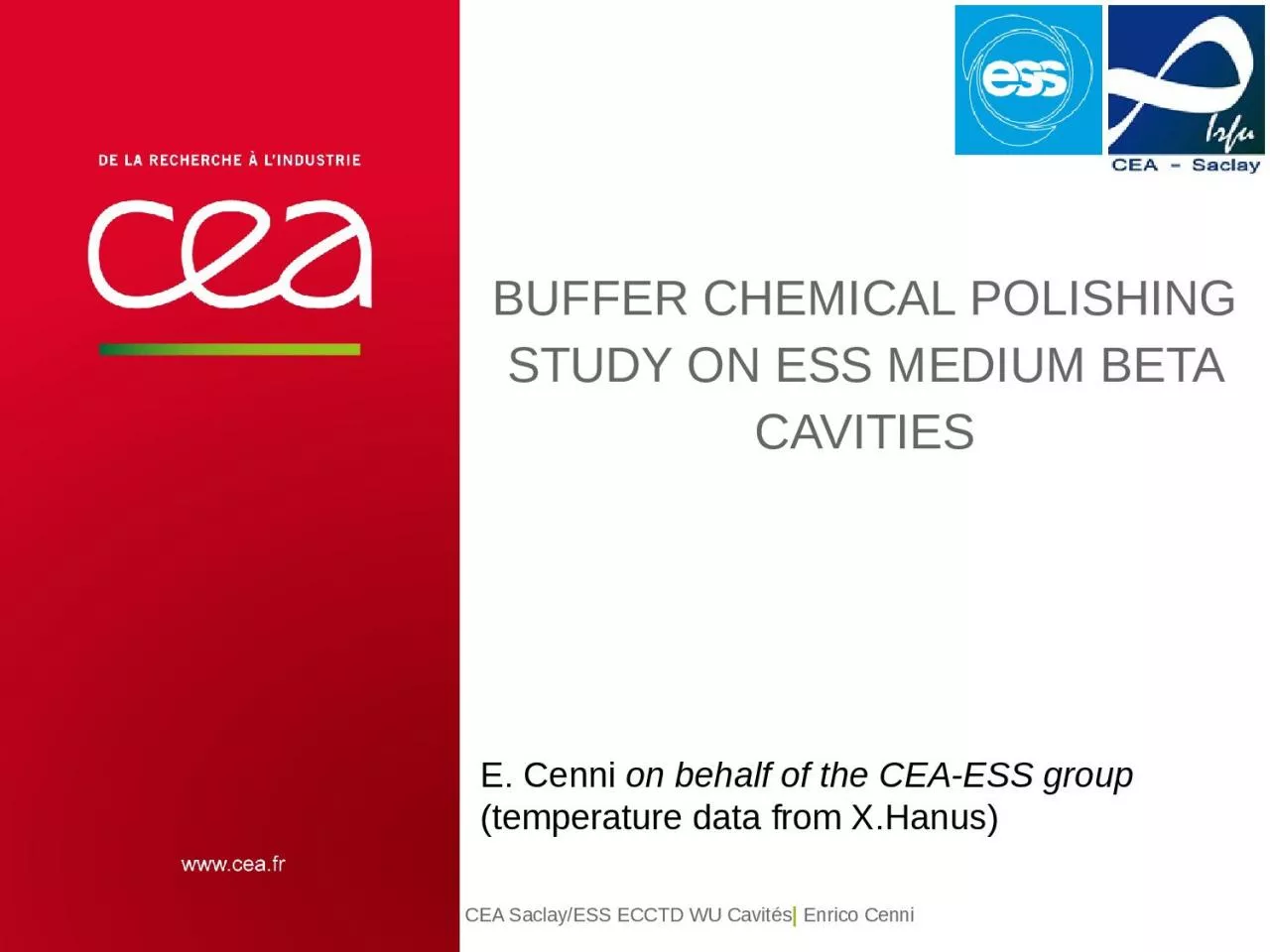

cavities CEA SaclayESS ECCTD WU Cavités Enrico Cenni E Cenni on behalf of the CEAESS group temperature data from XHanus PAGE 2 BCP system setup Motivation Temperature measures ID: 1015767
Download Presentation The PPT/PDF document "Buffer chemical polishing study on ESS m..." is the property of its rightful owner. Permission is granted to download and print the materials on this web site for personal, non-commercial use only, and to display it on your personal computer provided you do not modify the materials and that you retain all copyright notices contained in the materials. By downloading content from our website, you accept the terms of this agreement.
1. Buffer chemical polishing study on ESS medium beta cavitiesCEA Saclay/ESS ECCTD WU Cavités| Enrico CenniE. Cenni on behalf of the CEA-ESS group(temperature data from X.Hanus)
2. | PAGE 2BCP system setupMotivationTemperature measuresVertical test resultsSummaryOUTLINE
3. ESS MEDIUM BETA PROTOTYPES2 medium beta prototype (fine grain high purity Niobium)Cavity dataSurface1.8 m2Volume67 litersLength1258 mmEquator diameter370 mmIris diameter94 mm# cells6Frequency704.42 MHzCEA is involved in the design and prototyping for ESS medium and high beta elliptical cavities.The cavities will be installed into a prototype cryomodule.
4. BCP SetupBCP integrated system:200 liters acid tankHF/HNO3/H3PO4 1:1:2.4Flow: 20 l/minAcid flow
5. J. Halbritter, P. Kneisel, K. Saito. SRF93.Motivation Q-disease Still present after warm up No difference with faster cooling rateHydrogen diffusion during BCP? Need to optimize the BCP process for the pre-series
6. Some improvementIncreased the length of the acid tank cooling line.External tube to pre-cool the cavity.Temperature sensors on the external surface.
7. temperature curve featuresWater rinsingAcid flow stop and pumped out Acid touch the cavity surface ~ 2 °C/min~0.2 °C/minAcid tank temperature~0.2 °C/minBCP reaction produces about 2kW, we are able to remove only 1kW in the acid tank.Viscous layer formation?
8. One cell temperature distributionX. Hanus54321ΔT≈10°CΔT≈15°CAcid Flow
9. Thickness measurements Average removal ≈50µmRatio between top/bottom removal≈ 3-4Max=110µm, min=20µmAcid FlowThickness measurements performed by ultrasoundF. EozenouC. Servouin
10. Fluid dynamics Simulation resultsAcid speed [mm/s]Acid speed and velocity [mm/s]Inflow 20 l/minTemperature [°C]
11. Vertical test resultsTargetLeak+field emission
12. Surface resistance| PAGE 12ProcessRs @2K [nΩ]BCP ~200µm205Heat treatment+HPR20HT+BCP ~20µm10BCP 200µmHT+HPRHT+BCP 20µm
13. Summary and outlook| PAGE 13 We can’t control the temperature rise during the BCP without an external cooling Equip the cavity with a water tank? External tube? Bigger acid tank?We have observed a temperature gradient across the cell (looking for explanation).Viscous layer formation?Gas bubble formation? ~~~Analysis of polished and treated sample (similar to cavity) by SIMSTest of the second prototype (BCP with acid temperature <15°C)
14. Commissariat à l’énergie atomique et aux énergies alternativesCentre de Saclay | 91191 Gif-sur-Yvette CedexT. +33 (0)1 69 08 xx xx | F. +33 (0)1 69 08 99 89Etablissement public à caractère industriel et commercial | RCS Paris B 775 685 019| PAGE 14THANK YOU FOR YOUR ATTENTIONThanks to: X. Hanus, F. Peauger, P. Bosland, D. Roudier, C. Madec, F. Eozenou, C. Servouin, Y. Boudigou, G. Monnereau, T. Hemelin, J.P. Poupeau, Y. Gasser.
15. Commissariat à l’énergie atomique et aux énergies alternativesCentre de Saclay | 91191 Gif-sur-Yvette CedexT. +33 (0)1 69 08 xx xx | F. +33 (0)1 69 08 99 89Etablissement public à caractère industriel et commercial | RCS Paris B 775 685 019| PAGE 15BACK UP SLIDES
16. Vertical testsTargetQ disease curves
17. Medium beta cavity| PAGE 17 ParameterValueGeometrical beta - bgeom0.67Frequency [MHz]704.42Number of cells6Operating temperature [K]2Maximum surface field in operation [MV/m]44Nominal Accelerating gradient Eacc [MV/m] at bopt 16.7Accelerating length Lacc = (ncell.bgeom.l/2) [m]0.855Q0 at nominal gradient>5.109Cavity dynamic heat load [W]4,9Qext7.5 105Cell to cell coupling k [%]1.22p and 5p/6 (or 4p/5) mode separation [MHz]0.54Epk/Eacc 2.36Bpk/Eacc [mT/(MV/m)]4.79Maximum r/Q [W] at bopt394Optimum beta bopt0.705G [W]196.63 6 prototypes will be built, 4 will installed in the cryomodule 2 cell shapes (central cells and end groups)
18. SIMS surface analysis (Argon beam)| PAGE 18Ar+Nb+NbO+NbO2+Na+Ti+TiO+Fe+FeH+Ar++Ca++